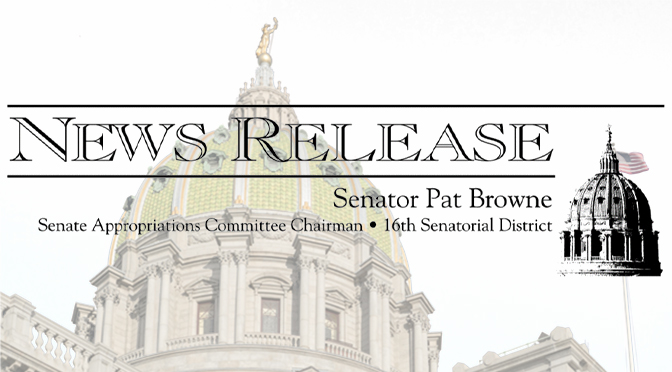|
|
The reconstituted Special Education Funding Commission today (December 15) released its report and recommended to the General Assembly adjustments to the state’s special education funding formula, according to co-chairs of the commission Senate Majority Appropriations Chairman Pat Browne (R-Lehigh), House Education Chairman Curtis Sonney (R-Erie) and Education Secretary Noe Ortega.
The reconstituted Special Education Funding Commission was established under Act 16 of 2019 to review the current formula that determines special education payments to school districts in Pennsylvania.
The commission recommended in the report revisions to the special education funding formula’s student weights based on results from a recent Independent Fiscal Office (IFO) survey that updated data since the current formula is based on Fiscal Year 2011-12 numbers.
The weighting factor changes are as follows:
- Category 1 from 1.51 to 1.64 (Student costs are less than $26,718)
- Category 2 from 3.77 to 3.08 (Student costs range between $26,718 and $53,436)
- Category 3 from 7.46 to 6.34 (Students costs are over $53,436)
In addition, the commission recommended using a three-year average of the student headcounts in each cost category instead of one-year average to give more predictability to school districts. The formula still includes factors reflecting community differences such as market value/personal income aid ratio, equalized millage rate and small and rural school districts.
“These recommendations by the commission and adjustments to the special education funding formula reflected by the information produced by the IFO build off the work done by the original Special Education Funding Commission back in 2013 by updating the formula to reflect more recent data,” Senator Browne said. “In addition, these recommendations provide more clarity and consistency for school districts regarding its projected special education costs in planning yearly budgets. These recommendations continue to consider the actual number of students needing specialized education services and refine how the actual needs of each student can be addressed.”
Other recommendations made by the commission include:
- Providing predictability to school districts when budgeting, setting – freezing – the data used in the annual distribution of special education funding as of June 1 prior to the budget year.
- Charging the Department of Education with collecting data for the next reconstituted Special Education Funding Commission to determine if there is a need to provide a new subset under Category 1 in the weighted student head counts that would better represent student costs. Category 1 contains the highest number of special education students (89 percent).
- Providing greater transparency by posting the special education contingency fund awards on the Department of Education’s publicly accessible website along with the Act 16 report data, including Category 1 counts.
- Setting a date for the next reconstitution of the Special Education Funding Commission for January 15, 2024 with the duty to make a report to the General Assembly no later than November 30, 2024.
“The pandemic has been especially difficult for our special education students and has resulted in more students being identified,” Rep. Sonney said. “The commission’s recommended changes will help to ensure that funds are distributed in a more equitable manner to provide more stability and transparency.”
The commission also made recommendations regarding the Special Education Contingency Fund. These recommendations include the consideration of changes to the contingency fund set-aside in light of the overall amount of funding available for Special Education. The report recognizes that any increase in the contingency fund set-aside without a proportionate increase to the overall appropriation level will negatively impact and reduce the general special education funding distributed through the formula to school districts. The commission recommended that if there is addition funding added to the contingency fund that the distribution of those funds be based on the cost of the student compared to the applicant’s total special education instruction costs.
In addition to Senator Browne, Rep. Sonney and Sec. Ortega, commission members included: Senators Maria Collett (D-12), Tim Kearney (D-26), Scott Martin (R-13), Bob Mensch (R-24) and Lindsey Williams (D-38); Representatives Joe Ciresi (D-146), George Dunbar (R-56), Mark Longietti (D-7), Mike Sturla (D-96) and Jesse Topper (R-78); Sherri Smith, Acting Secretary for Elementary and Secondary Education and Greg Thall, Secretary of the Budget.
State funding for special education is slightly more than $1.2 billion a year with an increase of $50 million in the Fiscal Year 2021-22 state budget. In schools with adequate resources, academic achievement for children with disabilities averages close to the results for all students.
The Special Education Funding Commission was originally established in Act 3 of 2013 to review and make recommendations regarding special education funding that determines how much each school district receives in special education payments. That commission was co-chaired by Senator Browne and Representative Bernie O’Neill.
The current special education funding formula, one of the original commission’s recommendations in 2013, was enacted and took effect for the 2014-15 fiscal year. The formula directs dollars to school districts that have the greatest need for additional resources based upon the cost of each special education student.
For more information on the report recommended by the commission, visit www.senatorbrowne.com or www.pahousegop.com.
Information provided to TVL by:
Matt Szuchyt
Deputy Director of Policy & Communications
Senator Pat Browne
Majority Appropriations Chairman
PA 16th Senatorial District
www.senatorbrowne.com





